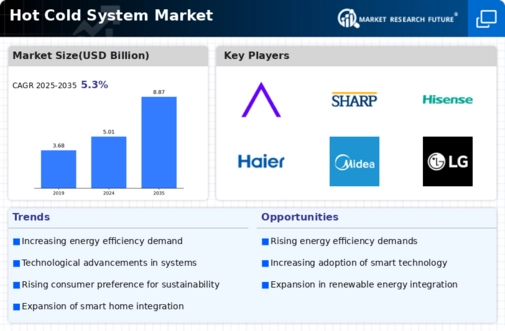Growing Demand for Energy Efficiency
The Global Hot Cold System Market Industry experiences a notable surge in demand for energy-efficient solutions. As energy costs continue to rise, consumers and businesses alike are increasingly seeking systems that minimize energy consumption while maximizing performance. This trend is particularly evident in regions where energy regulations are becoming more stringent. The market is projected to reach 5.01 USD Billion in 2024, reflecting a growing awareness of sustainability and cost savings. Energy-efficient hot cold systems not only reduce operational costs but also contribute to lower carbon footprints, aligning with global efforts to combat climate change.
Government Initiatives and Incentives
Government policies and incentives significantly influence the Global Hot Cold System Market Industry. Many countries are implementing regulations that promote the use of energy-efficient systems, providing financial incentives for consumers and businesses to upgrade their existing systems. These initiatives not only encourage the adoption of advanced technologies but also align with global sustainability goals. As governments prioritize energy efficiency and environmental responsibility, the market is expected to benefit from increased investments and consumer participation. This supportive regulatory environment is likely to propel market growth, contributing to the overall expansion of the industry.
Increased Focus on Indoor Air Quality
The Global Hot Cold System Market Industry is witnessing a heightened emphasis on indoor air quality (IAQ) as consumers become more aware of its impact on health and well-being. Systems that provide effective heating and cooling while ensuring proper ventilation are in high demand. This trend is particularly relevant in commercial spaces, where regulations regarding IAQ are becoming more stringent. The integration of air purification technologies within hot cold systems can enhance air quality, thereby attracting consumers. As awareness of IAQ continues to grow, the market is likely to expand, driven by the need for healthier indoor environments.
Technological Advancements in HVAC Systems
Technological innovations play a pivotal role in shaping the Global Hot Cold System Market Industry. The integration of smart technologies, such as IoT and AI, into heating, ventilation, and air conditioning systems enhances operational efficiency and user experience. These advancements allow for real-time monitoring and predictive maintenance, which can significantly reduce downtime and repair costs. As these technologies become more accessible, the market is likely to witness increased adoption rates. By 2035, the market is expected to grow to 8.87 USD Billion, driven by the demand for smarter, more efficient systems that cater to modern consumer needs.
Rising Urbanization and Infrastructure Development
Urbanization is a key driver of the Global Hot Cold System Market Industry, as rapid population growth in urban areas necessitates the development of robust infrastructure. Cities are expanding, leading to increased demand for effective heating and cooling solutions in residential, commercial, and industrial sectors. Governments worldwide are investing in infrastructure projects that require advanced hot cold systems to ensure comfort and efficiency. This trend is likely to sustain the market's growth trajectory, with a projected CAGR of 5.33% from 2025 to 2035. The need for reliable systems in densely populated areas underscores the importance of this driver.




















Leave a Comment